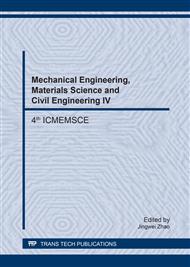p.3
p.7
p.12
p.21
p.26
p.31
p.35
p.43
p.49
Wrinkling Behavior of a Woven Thermoplastic Composite Material
Abstract:
This article examines the prediction of wrinkling initiation in self-reinforced thermoplastic composite materials for potential application in rapid forming of this class of materials. Whilst most of recent researches concentrate on examining metallic wrinkling behavior, this article aims to introduce a wrinkling indicator for composite sheet. The material system involved in the study is a self-reinforced polypropylene woven composite with a fiber orientation of 0°/90° along the warp and weft directions. Square specimens were stretched uniaxially along diagonal direction until the onset of wrinkling. It is observed that when the wrinkling occurs, strain increment ratio exhibits an abrupt change. This fundamental observation leads to the prediction of onset of wrinkling by using abrupt changes in strain increment ratio as a metric.
Info:
Periodical:
Pages:
26-30
Citation:
Online since:
March 2017
Authors:
Price:
Сopyright:
© 2017 Trans Tech Publications Ltd. All Rights Reserved
Share:
Citation:


